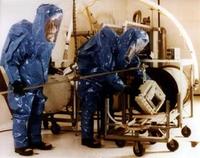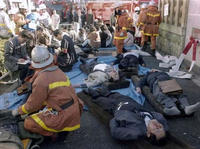-
Japanese attenuated smallpox vaccine shows promise in U.S. trial
An attenuated smallpox vaccine that was developed in Japan in the 1970s compared well with a conventional smallpox vaccine in a phase 1-2 clinical trial in the United States
-
-
Budget cuts could hurt biodefense efforts

With lawmakers struggling to reduce spending and cut the deficit, funding for government programs aimed at thwarting biological threats could face severe budget cuts; while the budget for overall civilian biodefense increased by 17 percent, that number is deceiving as federal agencies consolidated and combined several key programs under larger budget line item headings
-
-
Biological weapons: U.S. must not repeat the failure of imagination
Joel McCleary, a biological weapons expert, is the chairman and co-founder of Q Global and the founder of PharmAthene; he argues that the U.S. government has not done enough to protect the nation against a biological attack, warns of the need for presidential leadership, and underscores the dangers of biological weapons
-
-
Emergency medical response in a post-9/11 Washington, D.C.
Beverly Pritchett, the senior deputy director of the Health Emergency Preparedness and Response Administration at the D.C. Department of Health, is a 27-year veteran of the U.S. Army Medical Service Corps; Pritchett discusses improvements made to the city’s emergency medical response capabilities, the integration of smartphones and social media into disaster response plans, and the need for continued funding to sustain the gains made in public health over the past ten years
-
-
Anthrax exposure prompts FBI investigation
Government health officials are currently investigating a case of anthrax exposure in Minnesota after tests confirmed that an individual hospitalized there had been infected with the dangerous bacteria; due to the deadly nature of anthrax and its use as a biological weapon, the FBI joined Minnesota health officials in investigating the matter
-
-
Innovative biosensor for rapid virus field tests
Relying on a novel DNA-based bio-chemo-physical conversion method, a new bio-detection device is able to detect harmful bacteria, such as E. coli, salmonella, and staphylococcus, on site, within thirty minutes; it can be adapted to cover such deadly viruses as SARS, H5N1 flu, and swine flu viruses; it can also be designed to monitor possible biological attack from anthrax, smallpox, cholera, and more
-
-
Anthrax vaccine program demonstrates 36 month product stability
Maryland-based PharmAthene has achieved an important program milestone in its recombinant protective antigen (rPA) anthrax vaccine program, and demonstrated thirty-six month stability of its rPA drug product candidate; the data suggest that the rPA product candidate is both highly stable and potent; stability has historically been a stumbling block for other recombinant anthrax vaccine programs
-
-
PositiveID releases groundbreaking new biothreat detector
PositiveID Corporation recently unveiled its new Multiplex BioThreat Assay, which the company says is the first of its kind; according to PostiveID, its latest device is the first commercially available detector that can diagnose up to six bio-threat organisms in the Centers for Disease Control’s category A and B lists in a far shorter time than existing methods
-
-
Natural enzyme can defend against terrorists' nerve agents

Chemicals called organophosphates, found in common household insecticides, can be just as harmful to people as to insects; organophosphates could be released on an industrial scale, through an act of terror or accident, attacking the nervous system by inactivating an enzyme called acetylcholinesterase (AChE); scientists are devising drugs to treat and prevent the toxic effects of organophosphates and related chemicals
-
-
Nano detector spots deadly anthrax
The average time of detection of an anthrax attack by current methods — the time required for DNA purification, combined with real-time polymerase chain reaction (PCR) analysis — is sixty minutes; a new, automatic, and portable detector takes just fifteen minutes to analyze a sample suspected of contamination with anthrax
-
-
Pinellas County, Florida simulates anthrax attack
Last Wednesday a local health department in Florida staged an elaborate disaster exercise replete with angry mobs, fainting citizens, and shouting matches; the exercise, dubbed Operation MedStock, gave officials from the Pinellas County Health Department an opportunity to respond to a simulated anthrax attack
-
-
Biolabs: the solution may be the problem

Since the fall 2001 anthrax attacks, there has been a vast expansion of the U.S. bioterror research infrastructure; now, more than 11,000 scientists work on bioterrorism and agroterrorism research in seventeen major and many more smaller labs across the United States; billions of federal dollars are funding research on new vaccines and antibiotics to protect the population from anthrax, plague, tularemia, Ebola, and other lethal germs; what is the likelihood that there is another Bruce Ivins — perhaps more than one — among these thousands of researchers with access to the most lethal pathogens on Earth?
-
-
How safe is Kansas bio lab from twisters?

DHS officials say they are confident that the proposed bio-defense lab in Manhattan, Kansas, located in the heart of tornado alley, is capable of withstanding a direct hit from a powerful twister; engineers have hardened the $650 million National Bio and Agro-Defense Facility (NBAF) to withstand wind speeds of up to 230 miles per hour; but critics of the planned facility argue that the new standards are inadequate and that the facility must be further reinforced to ensure that in the event of a natural disaster the deadly pathogens and viruses stored there are not spread
-
-
Decision on smallpox virus destruction delayed for three years
After a second round of negotiations Tuesday, the World Health Assembly (WHA) agreed to postpone setting a date for destruction of the world’s remaining smallpox virus stocks for another three years; the assembly simultaneously reaffirmed previous statements that the virus stocks should be destroyed after “crucial research” is completed; several countries, mainly developing ones, pushed for immediate destruction of the smallpox virus stocks, while others suggested a short delay for setting a deadline; U.S. officials had introduced a resolution to retain the virus stocks for at least another five years to allow work on bioterrorism countermeasures to continue; U.S. Secretary of Health and Human Services (HHS) Kathleen Sebelius said, however, that the United States was committed to the eventual destruction of the virus stocks
-
-
Kansas House cuts troubled agency's role in funding of bio lab
DHS has chosen Kansas State University (KSU) in Manhattan, Kansas, as the location for the new, $650 million Level 4 BioLab, which will replace the aging lab on Plum Island, New York; the federal laboratory will be the U.S. premier facility for research into countering possible bioterrorism attacks and threats to the nation’s food supply; the Kansas Bioscience Authority (KBA) was supposed to handle the issuing of $105 million in bonds to develop the lab, but the KBA’s chief executive has recently resigned under a cloud, and the agency’s business practices are now being investigated the Johnson County District Attorney; the Kansas House voted to cut the KBA out of handling the bond issue; “We didn’t want any kind of hint of a problem,” said one House member
-
- All
- Regional
- Water
- Biometrics
- Borders/Immig
- Business
- Cybersecurity
- Detection
- Disasters
- Government
- Infrastructure
- International
- Public health
- Public Safety
- Communication interoperabillity
- Emergency services
- Emergency medical services
- Fire
- First response
- IEDs
- Law Enforcement
- Law Enforcement Technology
- Military technology
- Nonlethal weapons
- Nuclear weapons
- Personal protection equipment
- Police
- Notification /alert systems
- Situational awareness
- Weapons systems
- Sci-Tech
- Sector Reports
- Surveillance
- Transportation
Advertising & Marketing: advertise@newswirepubs.com
Editorial: editor@newswirepubs.com
General: info@newswirepubs.com
2010-2011 © News Wire Publications, LLC News Wire Publications, LLC
220 Old Country Road | Suite 200 | Mineola | New York | 11501
Permissions and Policies
Editorial: editor@newswirepubs.com
General: info@newswirepubs.com
2010-2011 © News Wire Publications, LLC News Wire Publications, LLC
220 Old Country Road | Suite 200 | Mineola | New York | 11501
Permissions and Policies
